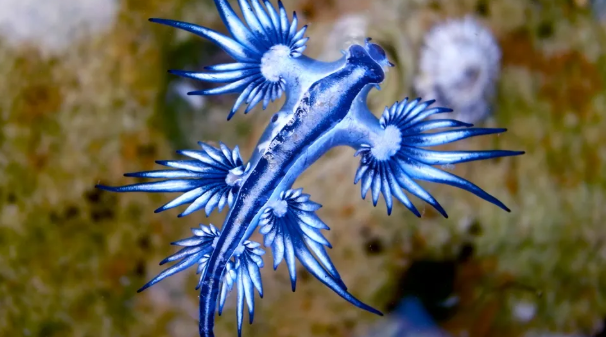By Sophia Byl
In one of last year’s ESN issues, we explored together the fascinating methods of a deep-sea creature known as the leaf sheep sea slug. It’s a fluffy, fairly cute slug, having been affectionately nicknamed “Shaun the Sheep” by marine biologists.
What makes the leaf sheep special is its ability of kleptoplasty, or “stealing” chloroplasts from the algae it eats. Those chloroplasts stay in the slug’s skin, allowing it to perform photosynthesis as well as eat regularly. It’s like a reverse carnivorous plant – instead of evolving to eat bugs when photosynthesis wasn’t enough, it added photosynthesis to its energy-fusing repertoire as a tool to keep in its back pocket.
But we aren’t going to talk about the leaf sheep sea slug today (Shaun the Sheep’s article is, however, on the ESN website, should you be so inclined to check it out). Rather, we’ll be diving into the survival tactics of one of its similarly vibrant cousins, known colloquially as the blue dragon.
The blue dragon is one of those creatures that fulfills the badass archetype of preying on animals multiple times larger than itself. It looks like a blue shark gummy, yet is quite a bit more dangerous. Take a look at those lovely, feather-like tentacles on the end of the slug’s appendages – known as cerata, it’s where the blue dragon stores potent venom. And how exactly does this nifty nudibranch obtain said venom? From munching on some of the ocean’s most toxic invertebrates, from the well-known Portuguese man o’ war to the oddly charming Velella velella, a floating creature commonly known as the by-the-wind sailor.
Since the dragon isn’t able to produce venom on its own, it is imperative that it receives a steady diet of these venomous animals. Finding them isn’t a difficult task, though – it’s what comes after that sets this sea slug apart from others. While floating upside down near the ocean’s surface, the blue dragon will produce a copious amount of venom-neutralizing mucus to protect itself from its prey’s toxins. Then, it makes a move with its large, serrated jaws.
The venom cells of whatever invertebrate the dragon was eating make their way through its stomach (also fortified to minimize chances of poisoning) and out into the cerata, where they’ll aid the dragon in catching its next little snack. What makes this feat twice as impressive is that the blue dragon is able to concentrate this venom within its cerata even more than its prey did. The result? The blue dragon has the potential to be even more toxic than the deadly animals it eats.
It’s all pretty incredible, especially when you consider how delicate the blue dragon looks on the outside. By a glance, you’d have no idea that it might be packing a venomous punch many times more powerful than that of a jellyfish. Thankfully, bright colors and patterns like the blue stripes on the slug’s back are the animal kingdom’s universal signal for “Stay back, I’m dangerous!” The trouble arises when humans fail to recognize that signal.
Blue dragons washing up on beach shores has become increasingly more common, likely due to rising sea levels. When beachgoers don’t leave wild animals alone or get the proper type of help, it can have harrowing consequences. So far, the dragons have been seen washing up mostly near the Gulf of Mexico and on Southeast Asian coasts, but there’s no telling where the ocean might take them next.
If you happen to see a blue dragon – or a marine animal you can’t identify – washed up on a shore where it can’t survive, it’s important to do something. You’re not only saving the animal, you might be stopping other people from getting hurt if they try to touch the animal, as well as raising awareness about the important issue of preserving the diversity of our biosphere.

